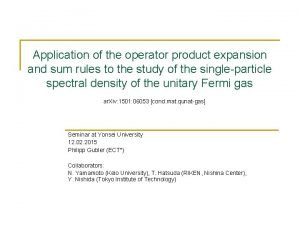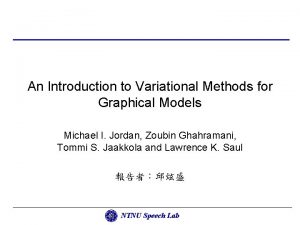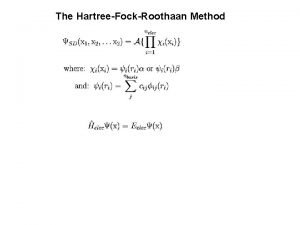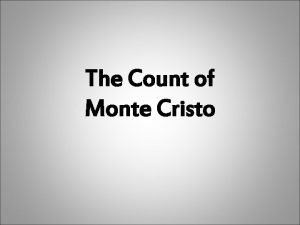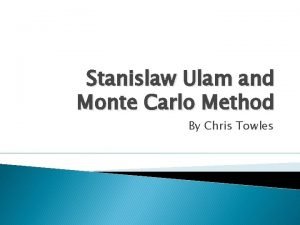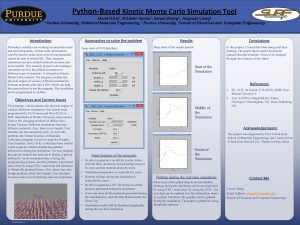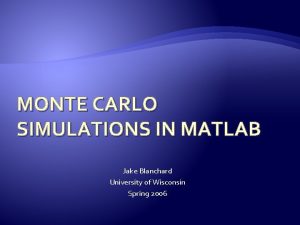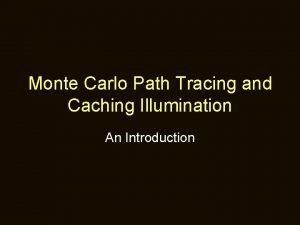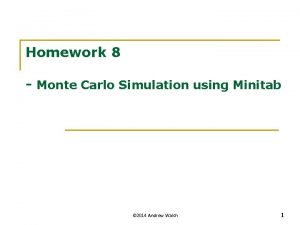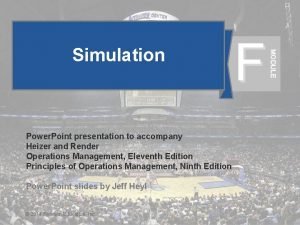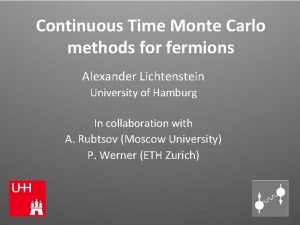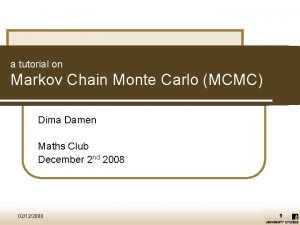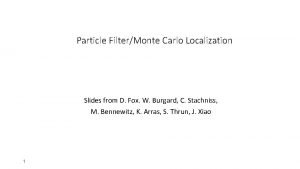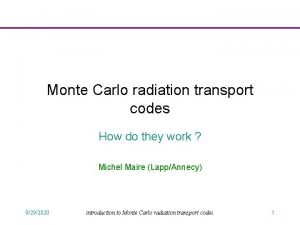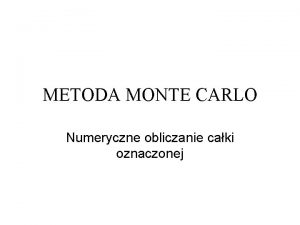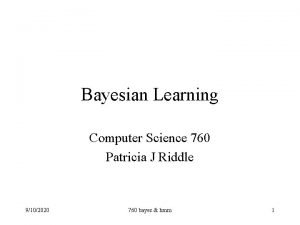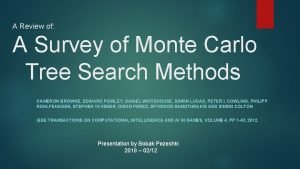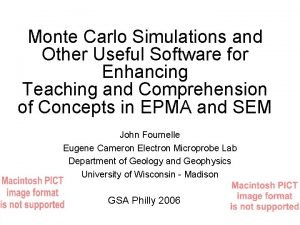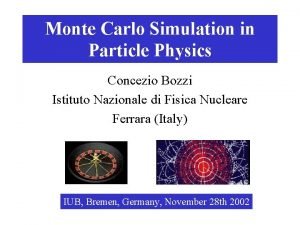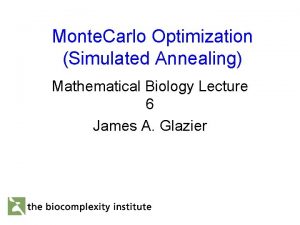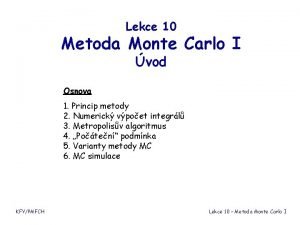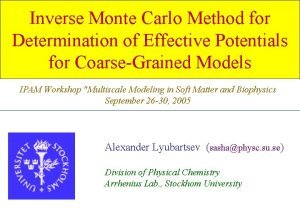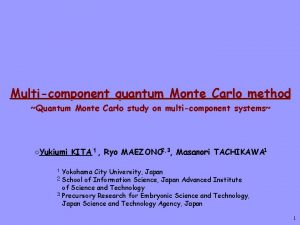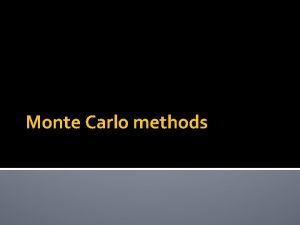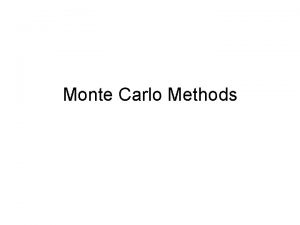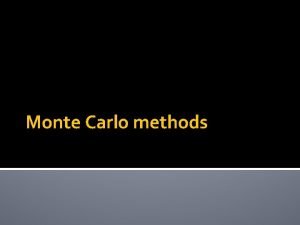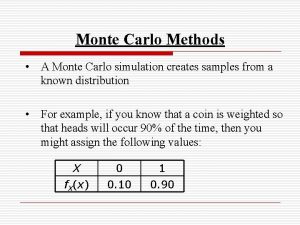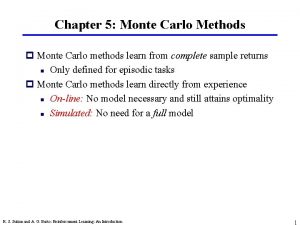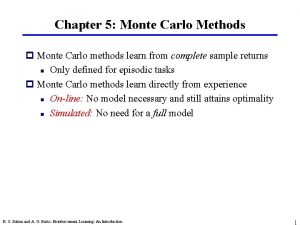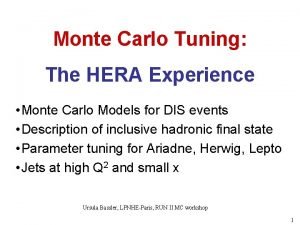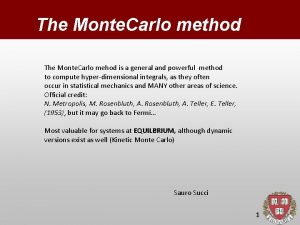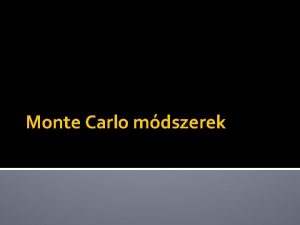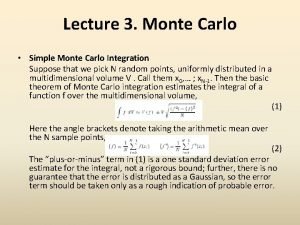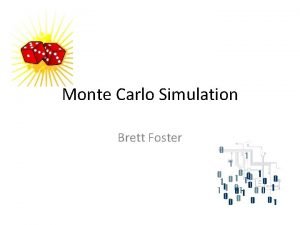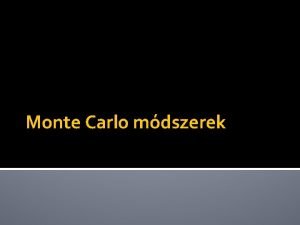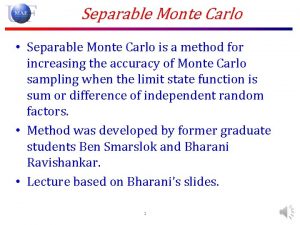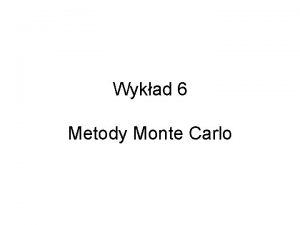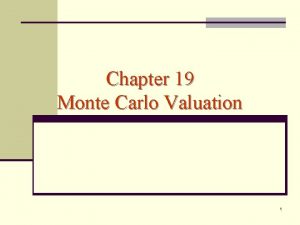10 Quantum Monte Carlo Methods Variational Principle For


























- Slides: 26

10. Quantum Monte Carlo Methods

Variational Principle • For any trial wave-function Ψ, the expectation value of the Hamiltonian operator Ĥ provides an upper bound to the ground state energy E 0:

Quantum Expectation by Monte Carlo where

Zero-Variance Principle • The variance of EL(X) approaches zero as Ψ approaches the ground state wave-function Ψ 0. σE 2 = <EL 2>-<EL>2 ≈ <E 02>-<E 0>2 = 0

Schrödinger Equation in Imaginary Time Let = it, the evolution becomes

Diffusion Equation with Drift • The Schrödinger equation in imaginary time becomes a diffusion equation: We have let ħ=1, mass m =1 for N identical particles, X is set of all coordinates (may including spins). We also introduce a energy shift ET.

Fixed Node/Fixed Phase Approximation • We introduce a non-negative function f, such that f = Ψ ΦT * ≥ 0 f is interpreted as walker density. f Ψ ΦT

Equation for f

Monte Carlo Simulation of the Diffusion Equation • If we have only the first term -½ 2 f, it is a pure random walk. • If we have first and second term, it describes a diffusion with drift velocity v. • The last term represents birth-death of the walkers.

Walker Space X The population of the walkers is proportional to the solution f(X).

Diffusion Quantum Monte Carlo Algorithm 1. Initialize a population of walkers {Xi} 2. X’ = X + η ½ + v(X) 3. Duplicate X’ to M copies: M = int( ξ + exp[- ((EL(X)+EL(X’))/2 -ET) ] ) 4. Compute statistics 5. Adjust ET to make average population constant.

Statistics • The diffusion Quantum Monte Carlo provides estimator for Where

Trial Wave-Function • The common choice for interacting fermions (electrons) is the Slater. Jastrow form:

Example: Quantum Dots • 2 D electron gas with Coulomb interaction We have used atomic units: ħ=c=m=e=1.

Trial Wave-Function • A Slater determinant of Fock-Darwin solution: • where

Six-Electron Groundstate Energy The (L, S) values are the total orbital angular momentum L and total Pauli spin S. From J S Wang, A D Güçlü and H Guo, unpublished

Quantum System at Finite Temperature • Partition function • Expectation value

D-Dimensional Quantum System to D+1 Dimensional Classical system Φi is a complete set of wave-functions

Zassenhaus formula • If the operators and Bˆ are order 1/M, the error of the approximation is of order O(1/M 2).

Trotter-Suzuki Formula where and Bˆ are non-commuting operators

Quantum Ising Chain in Transverse Field • Hamiltonian • where Pauli matrices at different sites commute.

Complete Set of States • We choose the eigenstates of operator σz: • Insert the complete set in the products:

A Typical Term Trotter or β direction (i, k) Space direction

Classical Partition Function Note that K 1 1/M, K 2 log M for large M.

Stochastic Series Expansion (SSE) • Base on the simple idea of series expansion for the partition • Works for models when weights can be made positive.

Spin ½ Heisenberg Model, “World Lines” Hb = I + H 1 + H 2, open bar indicates diagonal part of the Hamiltonian H 1, solid bar off-diagonal Hamiltonian H 2, flipping the spins. Red dot - spin up, open dot - down spin. “time” or “space”
 Quantum monte carlo
Quantum monte carlo An introduction to variational methods for graphical models
An introduction to variational methods for graphical models Variational principle
Variational principle The hamiltonian operator is given by
The hamiltonian operator is given by Count of monte carlo
Count of monte carlo Ulam monte carlo
Ulam monte carlo Contoh simulasi monte carlo
Contoh simulasi monte carlo Monte carlo vs temporal difference
Monte carlo vs temporal difference Kinetic monte carlo python
Kinetic monte carlo python Mcts tutorial
Mcts tutorial Monte carlo integration matlab
Monte carlo integration matlab Monte carlo path tracing
Monte carlo path tracing Monte carlo localization for mobile robots
Monte carlo localization for mobile robots Monte carlo simulation in minitab
Monte carlo simulation in minitab Monte carlo simulation advantages and disadvantages ppt
Monte carlo simulation advantages and disadvantages ppt Continuous time monte carlo
Continuous time monte carlo Markov chain monte carlo tutorial
Markov chain monte carlo tutorial Monte carlo localization python
Monte carlo localization python Monte carlo radiation transport
Monte carlo radiation transport Metoda monte carlo algorytm
Metoda monte carlo algorytm Viterbi algorithm
Viterbi algorithm Monte carlo search tree
Monte carlo search tree Monte carlo simulation freeware
Monte carlo simulation freeware Monte carlo simulation particle physics
Monte carlo simulation particle physics Monte carlo optimization
Monte carlo optimization Metoda monte carlo
Metoda monte carlo Inverse monte carlo
Inverse monte carlo
